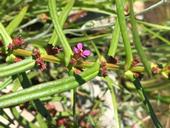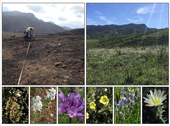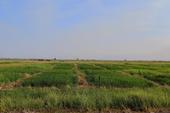- Author: Whitney B Brim-Deforest
- Posted by: Gale Perez

Background
White water fire (Bergia capensis) was found in September of 2023, by the Butte County Agricultural Commissioner's office in a rice field in Butte County. The weed was identified by the California Department of Food and Agriculture (CDFA.) It is the first find of this weed in California, and possibly in the United States. It is native to Africa, southern China, and tropical Asia, and it is known to be in rice fields in Europe, Central and South America, as well as the Caribbean. It was likely transported in seed to rice-growing areas and has been established in those locations for many years.
In Butte County, the weed was only found in one rice field, and the Agricultural...
- Author: Sarah Lorraine Marsh
- Posted by: Gale Perez

My name is Sarah Marsh, and I am excited to join UC Cooperative Extension as the new Rice Farming Systems Advisor serving Colusa and Yolo counties. I will be based out of Colusa at the Colusa UCCE office. I grew up on a diversified row-crop and orchard farm in Arbuckle and am grateful for the opportunity to serve the community in which I was raised. After completing my undergraduate degree in Plant and Environmental Soil Science at Texas A&M University, I obtained a M.S. in Horticulture and Agronomy at UC Davis, where I worked with Dr. Kassim Al-Khatib in studying weeds and herbicide resistance in rice agroecosystems. I have since worked in rice...
- Author: Christopher J Mcdonald
Roadsides are often a very difficult place to control weeds. Weeds thrive on roadsides and roadsides and rights of way are obviously long and narrow. Weeds along the edge of the shoulder need to be cleared to reduce fuels to prevent wildfires, and to ensure safety for drivers and also so that weeds do not damage the road surface or shoulder structure.
Herbicide applications on roadsides are often conducted at large scales where several acres to many acres are treated in a day. Roadside equipment can also be highly specialized ensuring large stretches of public roads and adjacent lands are better protected.
Herbicide applications on roadsides should be calibrated to ensure the amount of herbicide applied is the amount...
- Author: Justin Valliere

Wildfire is an important ecological process that shapes patterns of plant diversity in many Mediterranean ecosystems, including California. In coastal sage scrub and chaparral, for example, plant diversity is often highest in the growing seasons immediately after a site burns, with many fire-following species emerging from the soil seed bank and bud bank. This often results in spectacular displays of wildflowers when sufficient rainfall occurs following fire.
In a recent study published in Global Change Biology, however, we found that persistence of these unique, fire-following wildflowers may be threatened by invasive plant species as well as nitrogen...
- Author: Aaron Becerra-Alvarez
- Author: Sarah Lorraine Marsh
- Author: Kassim Al-Khatib
- Posted by: Gale Perez

A new herbicide for early-season weed control in water-seeded rice will be available soon. The herbicide active ingredient (a.i.) is pyraclonil, which will be trademarked as Zembu™ (1.8% a.i.) by Nichino, America Inc. The mode of action is a protox porphyrinogen (PPO)-inhibitor or Group 14. This herbicide is formulated as a granule and will be used as a residual preemergence for application on the day of seeding onto flooded fields. The use rate is 14.9 lbs ac-1 applied by air. While this herbicide is not a new mode of action for water-seeded rice, it is a new mode of action for early-season residual weed control. Pyraclonil is widely used for weed control in paddy fields worldwide and is the most commonly utilized...


